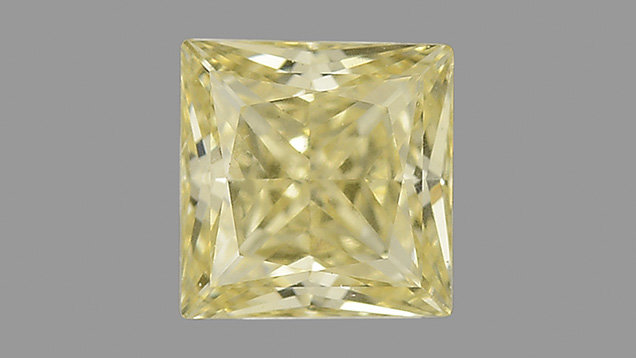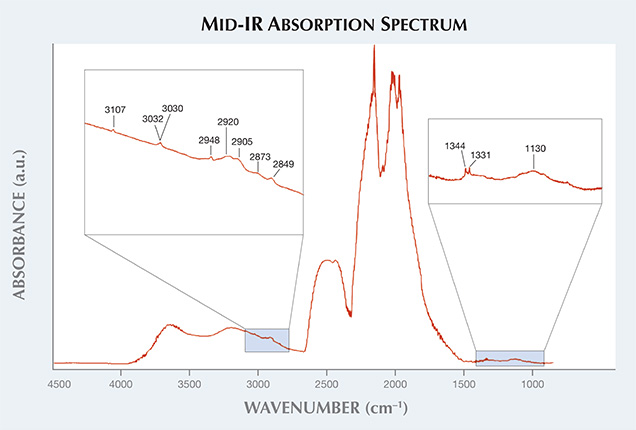Yellow CVD Synthetic Diamond

As is typical for CVD synthetics, the strong silicon-vacancy ([Si-V]–) center was detected as a doublet at 736.5 and 736.9 nm in the 633 nm PL spectrum. The mid-IR spectrum showed a single substitutional nitrogen atom (Ns0) at 1130 and 1344 cm–1 (figure 2). The nitrogen content, which contributed to the yellow color, was calculated from absorption bands in the 1000–1400 cm–1 mid-IR spectral region as 4.5 ppm. Nitrogen can be unintentionally introduced during the growth process; it can also be added deliberately to control the growth rate of single-crystal CVD synthetic diamond. DiamondView images showed curved green lines, indicating changes in conditions during growth (figure 3, left). The DiamondView also revealed green and greenish blue regions of pronounced growth events near the culet, as in the middle image of figure 3. A graphitized stress halo (figure 3, right) and small feathers on the girdle were observed under the microscope. Typical CVD strain—a localized tatami-like structure with low-strain interference colors—was visible under cross-polarized light.

Figure 2. The yellow CVD synthetic’s mid-IR spectrum revealed single substitutional nitrogen atoms (Nos at 1130 and 1344 cm–1. The diamond Raman band was detected at 1331 cm–1. A hydrogen-related defect was detected at 3107 cm–1, and C-H defects could be observed at 2948, 2920, 2905, 2873, and 2849 cm–1. An unknown doublet was also observed at 3030 and 3032 cm–1.

Figure 3. DiamondView imaging revealed curved green lines, reflecting changes in growth conditions (left). Pronounced growth events were also observed in green and bluish green regions near the culet (middle). Microscopic examination revealed a graphitized stress halo (right, magnified 112.5×), along with small feathers on the girdle (not shown). Images by Kyaw Soe Moe.
Post-growth treatment was detected: a hydrogen-related defect at 3107 cm–1 and C-H defects at 2948, 2920, 2905, 2873, and 2849 cm–1 (again, see figure 2). We did not observe the neutral charge state of the nitrogen vacancy–hydrogen complex ([N-V-H]0) at 3123 cm–1. These results suggested that the sample was HPHT-treated. An unknown doublet at 3030–3032 cm–1 was also found. Strong N-V (nitrogen-vacancy) defects at 575 (NV0) and 637 (NV–) nm were detected in PL spectrum using a 514 nm laser. The negatively charged nitrogen vacancy–hydrogen complex ([N-V-H]–) is usually contained in as-grown nitrogen-doped single-crystal CVD synthetic diamond, but it is unstable. After HPHT treatment, the hydrogen atoms were dissociated, causing C-H and N-V defects to form. Additional defects, such as H3 and H2, were also detected. Both centers could be introduced in as-grown CVD synthetic diamonds by HPHT annealing. The H3 centers were responsible for the observed green dislocations in the DiamondView image. As-grown CVD synthetic diamonds usually possess an unattractive brown color component. This can be removed by HPHT treatment to achieve an attractive yellow color, as observed in this sample.Type Ib CVD synthetics are also of interest for technological applications, especially for quantum computing (see E. Gibney, “Flawed to perfection: Ultra-pure synthetic diamonds offer advances in fields from quantum computing to cancer diagnostics,” Nature, Vol. 505, 2014, pp. 472–474). The N-V electron spin could be used as a basic unit of quantum computing, known as a quantum bit or “qubit.” Qubits are not limited to the binary “0” or “1” states of bits in traditional computers, but can simultaneously exist in both binary states and any state in between—a difficult concept to grasp but one that will lead to vastly enhanced computational capacity. Type Ib yellow CVD diamonds of micrometer size were grown and subsequently electron beam–irradiated and annealed by P. Neumann to create NV centers, as noted in his 2012 PhD thesis, “Towards a room temperature solid state quantum processor: The nitrogen-vacancy center in diamond.” After irradiation, the color changed from the as-grown yellow to green, then to purplish pink after annealing.



